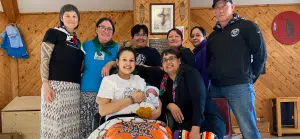By Jaryn Vecchio
It took more than 50 years, but Sturgeon Lake First Nation is celebrating another midwife-assisted birth.
Ashley Rabbitskin officially welcomed her son Kaleo on Wednesday at 7:01 a.m., after going into the early stages of labour a week earlier.
A naming ceremony was also held in January where Kaleo was given the Indigenous name Osōwihwiyāsis by an elder also known as a knowledge keeper.
Instead of going to a hospital, Ashley decided to give birth at the First Nation’s Healing Lodge.
Norma Rabbitskin, Ashley’s mother and Kaleo’s grandmother, told paNOW her daughter got to experience the miracle of childbirth in a culturally rich atmosphere.
“A singing type of ceremony was done, lighting the fire … all of the traditions that go and support the birth were honoured with this little guy,” Norma said.
Two midwives, one from Manitoba and the other from Ontario, were brought in by the National Aboriginal Council of Midwives to help with the birth.
Choosing early on to give birth like past generations, Ashley was able to experience the entire cultural process during her pregnancy.
This included teachings from elders, observing the lunar cycle, and taking part in smudging once a month.
“All of the special ceremonies that have been grounded with this pregnancy, it’s all the more very special as well as delivering with our Aboriginal midwives,” added Norma.
Cultural birthing centre
The SLFN isn’t planning on waiting another 50 years before experiencing another midwife-related birth.
It’s currently in the process of creating a first-of-its-kind birthing centre.
The centre is expected to have four birthing areas, room for families and midwives, an exam room, a kitchen, quiet rooms, and a birthing tub.
Those who want to give birth at the centre will also need to take in their culture.
“It’s more of a cultural ceremonial way that we believe will set the tone for that child for the rest of their life,” added Shirley Bighead, director of health for SLFN.
In the meantime, around 30 moms have started the cultural process of having a midwife-related birth. The First Nation is planning to only move forward with low-risk births until the centre is up and running.
Over 50 years in the making
One of the last to experience a cultural birth on the First Nation is now a band councillor.
Christine Longjohn got the news many in the community have been waiting years for while on vacation in Banff.
“(It’s) pure love when you first see that newborn and that’s the feeling I got,” she said. “I’m on top of the mountains here and we gave thanks for the new life, for opening those doors.”
Longjohn was told stories about her birth, specifically when her mother brought her to a hospital shortly after and the two were separated.
To her, that’s how their cultural births differ.
“If I was kept in my community, I would have been greeted with love,” Longjohn said. “That’s not the way we should be bringing babies into our world. We need to make sure they’re welcomed.”












